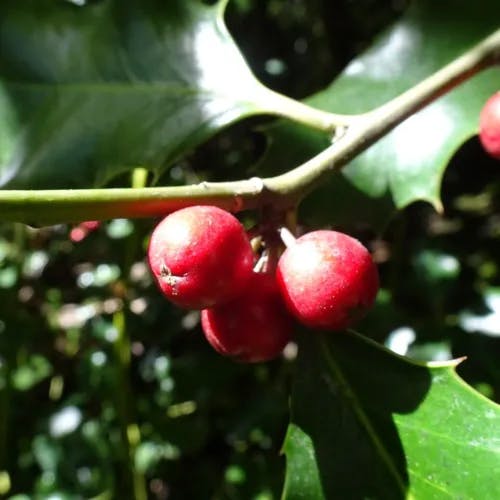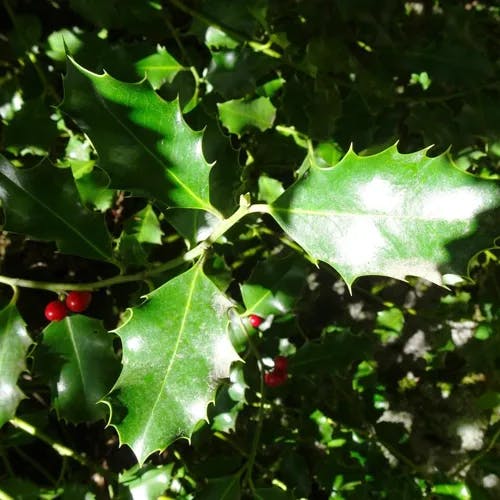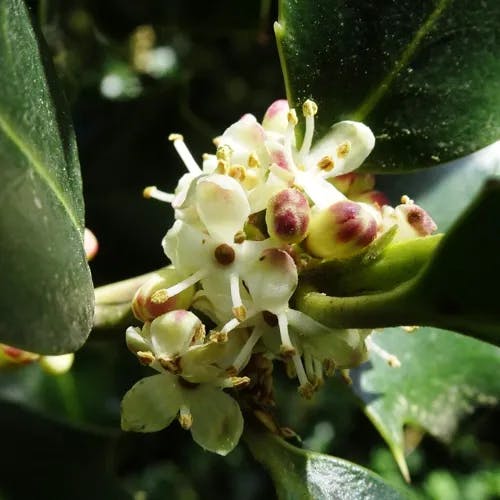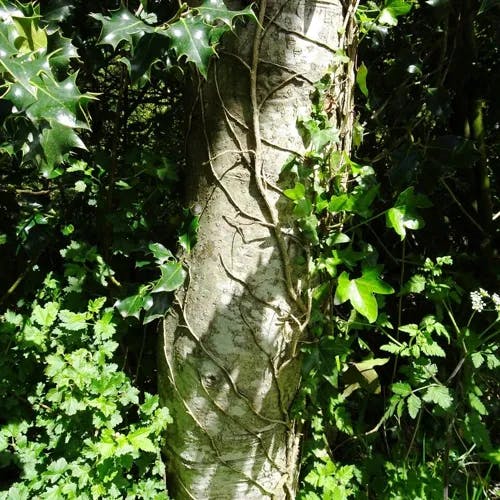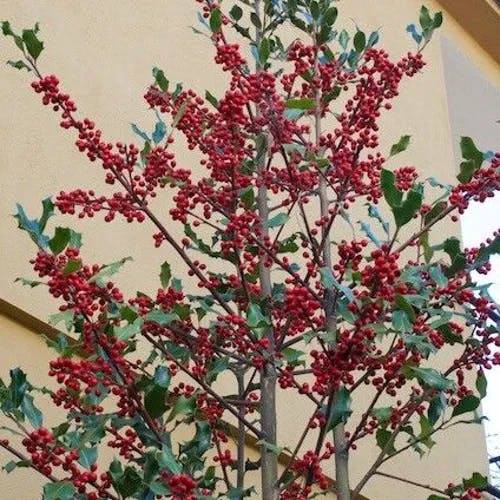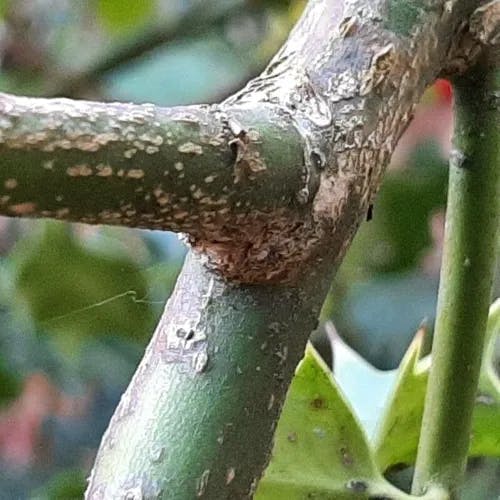The evergreen shrub or medium-sized tree with the botanical name Ilex aquifolium and also called English holly can attain 10 meters in height. This woody plant is indigenous to southwest Asia, northwest Africa, and western and southern regions of Europe. This species belongs to the Aquifoliaceae family and has glossy and spiny-margined, leathery, elliptical leaves with a dark green hue. The small, white, pleasant smelling flowers appear in late spring and early summer. The bright red berries ripen in fall and stay on the plant in winter, providing food for birds when it is cold. Because of its attractive leaves and berries, English holly is frequently planted ornamentally in landscaping and Christmas decor. It represents defense and protection and has cultural meaning in traditions and folklore. English holly thrives best in partially shaded sites with well-draining soil. Growth is slow but needs little pruning. Some pests and diseases like leaf miner and powdery mildew can affect the plant.
English holly
- Scientific name
- Ilex aquifolium
Basic Information
- Aquifoliaceae Family Ilex Genus English holly Species
- Aquifoliaceae > Ilex > Ilex aquifolium
- 83%
- The Completeness of This Encyclopedia
Please help us complete the encyclopedia, Terrarium is a encyclopedia service to be completed with everyone in the world. Currently, this page is 83% complete. For more information on how to contribute, please click here.
- Tree
- Height
- 1000cm ~
- Flower Color
- Leaf Color
- Anthesis
- spring
- Sunlight Exposure
Full Sun Long hours of sunlight from morning to afternoon Partial Shade A location in the shade of a tree or where either the morning or afternoon is shaded Full Shade A place where there is no direct sunlight
- Full Sun
- Hardiness Zones
This is an indicator to know to which zone each plant can winter. Knowing the zone of each plant gives you an idea of the cold temperature resistance when grown in the ground without a roof. 2: -42.7 to -40.0 3: -39.9 to -34.4 4: -34.3 to -28.9 5: -28.8 to -23.3 6: -23.2 to -17.8 7: -17.7 to -12.2 8: -12.1 to -6.7 9: -6.6 to -1.1 10: -1.0 to 4.4 11: 4.5 to 10.0
- 5
- Cold resistance
- Excellent
- Heat resistance
- Fair
- Habitat of origin
- Europe
- Growth Rate
- Slow
What is English holly (Ilex aquifolium)?
What is English holly (Ilex aquifolium)
Flower meaning
The versatile English holly (otherwise called ilex aquifolium) shrub is historically employed throughout the States for symbolizing protection and reinforcement. This originates from its prickly leaves and vivid crimson berries that indicate power and strength. Evergreen trees similar to the English holly further emphasize its steady character. While the cipher of florals differs through centuries, people, and places, the emblem of the English holly as a shielding bush persists. It communicates the safekeeping of cherished people and resisting difficulty. English holly lacks links to a precise month or date. But it decorates for Christmas owing to its celebratory form. Remember the floral cipher is open to interpretation and cultural frameworks.
Calendar of English holly (Ilex aquifolium)
Calendar
The native regions of English holly (Ilex aquifolium) encompass western and southern sections of Europe, areas of northwest Africa, and southwest Asia. In the USA, English holly is frequently grown as an attractive plant. When English holly blooms depends on the particular variety and conditions. Overall, the flowers open in late spring or early summer, often during May or June. At this time, the blossoms are most vivid, with bright colors that entice pollinators. Blooming typically persists for several weeks, as individual flowers last around one week. Offering adequate sunlight, water and nutrients can lengthen the duration. Pruning after flowering might also promote new growth and potentially continue blooming.
How to grow English holly (Ilex aquifolium)
Watering
The evergreen foliage of Ilex aquifolium thrives with occasional saturating irrigation, peculiarly amid the flourishing season. Ideal hydration frequency approximates one instance per seven to ten days, equating with climatic conditions and the dirt category. Substantial aqueous application, encouraging profound root extension, assists the bush in tolerating drought. During summer's elevated air temperatures and evaporation percentages, more recurrent hydration becomes imperative. However, overhydration hazards cause root deterioration and associated troubles. Examining dirt and moisture by inserting a finger verifies timing. If the shallow dirt seems arid, irrigation is warranted. Dormancy-lessened winter watering circumvents waterlogging and root problems. Only hydrate arid ground, but avoid complete desiccation. Appropriate humidity sustains English Holly's health. Draining the soil prevents waterlogging and possible root rot. Compost enrichment can refine drainage and water retention.
Soil and Fertilizer
The tree clinically titled Ilex aquifolium prospers in terrain possessing adequate drainage and somewhat acidic to impartial chemical balance ranging from 5.0 to 7.0 pH measurement units. It favors loam or sandy terrain abundant with organic compounds. The soil condition ought to remain damp however not saturated, since overabundance fluid results in root system decay. To guarantee ideal maturation, a balanced slow-discharge fertilizer ought to be applied during the spring before fresh development starts. The fertilizer ought to have an NPK proportion of 10-10-10 or something like that, giving rise to equal proportions of nitrogen, phosphorus, and potassium. Apply the fertilizer as indicated by the producer's directions, taking care not to over-fertilize, as this can cause leaf consumption and different issues. During the developing period, extra applications of a water-dissolvable fertilizer with a higher nitrogen content, for example, a 20-10-10 recipe, can be valuable. Apply the water-dissolvable fertilizer at regular intervals 4-6 weeks from spring to ahead of schedule fall, following the suggested measurement on the bundling. Frequent soil testing is suggested to screen the pH level and supplement substance of the soil. Changes can be made dependent on the test results to keep up with ideal soil conditions for this tree.
Sunlight and Place
The plant Ilex aquifolium, known scientifically as English holly, displays moderate cold endurance. It can bear lows of about -10°C (14°F) without major damage, but extended exposure to temperatures under -15°C (5°F) can injure the plant. Regarding heat tolerance, English holly can handle highs up to 30°C (86°F) with no ill effects. It prefers an ideal temperature range of 15–25 °C (59–77 °F) for best growth. During the summer, English holly should be put in a spot with partial shade to protect it from intense sunlight. It can take full sun exposure, but too much heat and direct sunlight can lead to leaf scorching. For sunlight needs, English holly thrives in zones that get at least 4-6 hours of direct sunlight daily. Not enough sunlight can lead to poor growth and fewer berries. In winter, English holly can handle cold temperatures and does not need any special protection. It is a sturdy evergreen plant that keeps its leaves all year. However, in very cold areas, adding a layer of mulch around the plant's base can help protect the roots from freezing.
Advanced Information of English holly (Ilex aquifolium)
Pruning
English holly's scientific name is Ilex aquifolium. It requires steady pruning and cutting back for shaping, healthy development, and controlling size. Removing dead, hurt, or sick branches and thinning packed areas is necessary. Cutting back can also revive an overgrown or lanky English holly. The optimal time for pruning is late winter or early spring before new growth starts. This allows fast recovery and lowers frost damage risk. Make clean cuts above a bud or side branch using sharp, sanitized tools. Avoid cutting the main stem or taking off over one-third of leaves at once. After pruning, clear debris and fallen leaves around the base to stop disease spread. Apply mulch for moisture conservation and weed suppression. Regular watering and fertilizing also helps recovery and health.
Planting and Harvest
The botanical name of English holly, a common evergreen plant, is Ilex aquifolium. When cultivating this shrub in containers, proper drainage through holes is vital to prevent excess moisture. A well-draining potting mixture should fill the planter. After carefully situating the roots, surround them with more mix, gently compacting them. Immediately, water thoroughly upon planting. Maintain steady but not excessive wetness in the soil. Every 2 or 3 years, transfer the plant into a somewhat larger pot with fresh medium, first loosening the roots. Issues like root decay or yellow leaves can result from poor care. Supply adequate sunlight, regular watering, and protection from temperature extremes to avoid problems. Pruning can help shape the plant and encourage healthy growth. With appropriate care, this versatile shrub thrives both inside and out.
Propagation
The red berries of English holly are ripe for harvesting when they attain a vivid crimson color. To increase your holly population, you may use various propagation techniques. For instance, you could carefully split up the root clumps and replant the divided sections. Alternatively, you could take cuttings from healthy plants, remove some leaves, and plant them in the soil after dipping the stems in the rooting agent. Leaf cuttings are another option - simply cut leaves into pieces and insert them vertically into the ground. Seeds are also viable for propagation if they are soaked first and then sown in suitable soil. With patience and the right conditions, new English holly plants will grow.
Pests and Diseases
The English holly plant, known by its scientific name Ilex aquifolium, can be affected by various insect pests and fungal diseases throughout its lifecycle. Monitoring the health and spotting early signs of infestation are critical to protect the plant. Small flies called holly leaf miners lay eggs on the leaves, and the hatched larvae bore inside, causing brown dead areas. Regular inspection and removal of damaged foliage helps prevent spread. Another sap-sucking bug called the holly scale attaches to stems and leaves, resulting in yellowing and wilting. Early treatment with horticultural oils or soaps may control populations. Fungal leaf spot diseases also disfigure the plant's appearance. Water splash spreads the spot-causing Phyllosticta fungus. Good air circulation and avoidance of overhead watering reduces its spread. Powdery white mildew is another fungal disease affecting hollies. Preventing overcrowding improves air flow and lowers disease risk. In summary, monitoring for pests like leaf mining flies and scale insects along with diseases like leaf spot and powdery mildew allows early action to protect English holly plants. Careful maintenance and sanitation practices also help avoid infestations.
Habitat of English holly (Ilex aquifolium)
Habitat
Toxicity of English holly (Ilex aquifolium)
Health Benefits
- edible
- Inedible
- Toxic
- toxic
NO DATA
Toxic for dogs and cats
NO DATA
Q&A of English holly (Ilex aquifolium)
- What Are the Characteristics of English Holly Leaves?
Holly, has a glossy, dark green leaves in season with Christmas decoration. Scientific name Ilex aquifolium, those leaves are spiny and sharp along the edge. The color underneath is lighter compare to the top side. Those leaves attach alternately along stem. The shape is mostly oval, stiff to touch. Generally they have uneven edge. Holly's leaves do not fall off like other trees in autumn. They stay green for whole year, that's why it becomes so popular when Christmas comes.
0
0
- Is there a recommended way to choose Ilex aquifolium?
The stately evergreen English holly plant has lustrous decorative leaves and vivid scarlet fruit. When picking English holly varieties, weigh up their increase habit, proportions, and production of berries. 'Alaska' is a female variety overflowing with brilliant red berries and a packed increase habit. 'Golden King' is a male variety with multicolored foliage and no berries. 'Silver Queen' has silver-edged leaves and crimson berries. 'J.C. van Tol' is a self-fertile variety generating big, vivid red berries. When obtaining English holly seeds, confirm they are fresh and feasible. Seek out plump, firm seeds lacking indications of impairment or mold. Seedlings should possess healthy, green vegetation and a well-formed root organization. Shun seedlings with yellow or wilted leaves, as they may be stressed or infected. Proper choice of English holly varieties, seeds, and seedlings will guarantee thriving growth and a stunning addition to your garden.
0
0
- How to Grow and Maintain an English Holly Hedge?
For development and upkeep of a barrier of English Holly or Ilex aquifolium, embark by situating juvenile specimens of holly in terrain with proper drainage and exposure ranging from complete to incomplete sunlight. Guarantee the earth possesses somewhat acidity and is copious in organic constituent for exemplary maturation. Habitual irrigation is imperative, markedly during arid intervals, nevertheless avoid oversaturating as it may source fungal infection of the roots. Annually prune the barrier in the late winter or at first spring to sustain its profile and encourage denser fabrication. Recall, English Holly is dioecious, signifying you'll necessitate both masculine and feminine organisms adjacent for production of berries.
0
0
